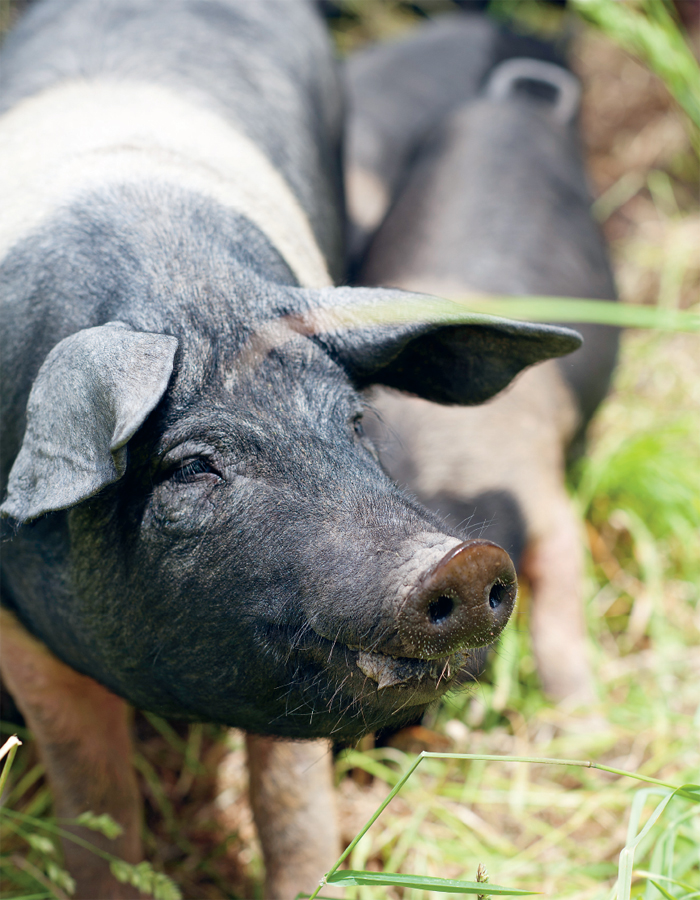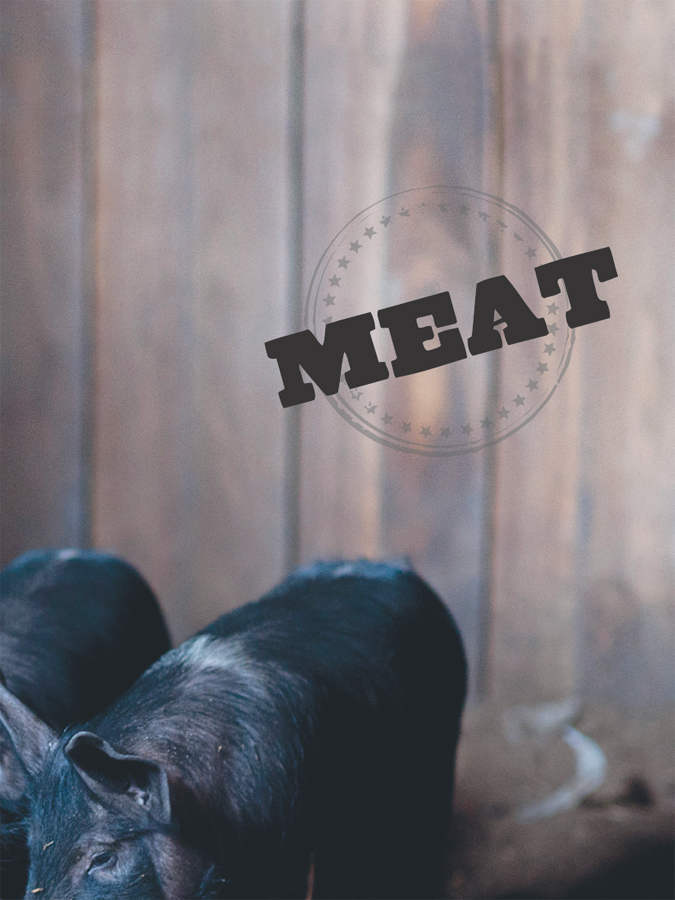WHY, YOU MAY ASK IN A TIME OF UBIQUITOUS REFRIGERATION, BOTHER TO PRESERVE MEAT? OR MAKE YOUR OWN BANGERS WHEN EVERY BUTCHER WORTH THEIR FLOSSY SALT IS MAKING THEM?
Well, the reason is plain and simple: flavour. If you want something better than money can buy, something unique, tasting more of itself and unlike many commercial products that frequently take shortcuts, then doing it yourself fits the bill.
Its no wonder modern sausages have been termed surprise bags for all the mystery meats that go into them. Its no wonder people are disappointed by bacon that leaches water and smells like fish when it is cooked. Its not surprising to realise that most people think that ham should taste like smoke flavour instead of a smokehouse, when most of the stuff for sale has never actually been near real smoke or a flame.
Preserving your own meat is an inexact science, an endlessly rewarding project where the results are as individual as those who make them. Was it a wet winter? Then the prosciutto may be softer than last year. Is the pork for the bangers from a Wessex Saddleback rather than a Berkshire this time around? If so, the meat will be sweeter. Is the wood for smoking the bacon apple wood rather than eucalypt? The beef from a three-year-old rather than a 14-month-old steer? Everything changes, and with that change comes infinite possibility and variation. Get out the sausage cannon, fire up the smoker, ring up the butcher or kill the pig yourself and get prepared for the flavours of yesterday.


SMOKING
Curing is one way of preserving food, smoking it is another. However, without curing, smoking is relatively ineffectual and cured and smoked food lasts longer than either process alone. This is because the smoke acts in two ways: to dry the food and to sanitise (sterilise) the outside of it.
Smoking is both an art and a science, and good, consistent smoking can take years to perfect. The good news for the home smoker is that just about anything you smoke yourself will taste better than most of the stuff you buy. Partly its because you know what goes into your food and can eat it shortly after smoking, and partly because so many smoked products arent actually smoked at all, just flavoured with a smoky-tasting chemical or residue.
The important things to think of when smoking are how you will cure the ingredient, whether youll hot or cold smoke it, and what kind of smoke youll create. Not only are various woods used, you can also use tea, sugar and anything natural that burns. But there are some limitations. For any kind of smoking you must not use resinous wood. This includes many soft woods, but in particular avoid using pine. Good hardwood isnt resinous, so the wood from most fruit trees is a good option as it produces a flavoursome smoke, each variety with its own unique properties. The wood for smoke is important, but you can control flavour just as much with the brine and cure. We use Tasmanian hardwood for much of our smoking because its plentiful, cheap (free when we cut firewood) and works well with full-flavoured free-range old-breed pork.
Building your own smoker can be as rudimentary or as complicated as you want. An old biscuit tin can have holes punched through, be placed over a low flame and used to hot smoke small cuts or fish, such as trout or eel. A 44 gallon drum can be converted to a fire box by cutting holes near the base to let in air, then drilling smaller holes near the top to insert metal hanging rods. You can dodgy up a makeshift cold smoker using plywood to form a box, placing it on a raised platform, and having a separate fire pit with a metal flue to draw up the smoke into the box. Some people use old fridges as the smoker, or old cookers. All you need is a fairly enclosed space with some room for the smoke to draw out the top, and a place where you can have a small fire going that wont set the food (or the smoker!) alight. Weve used little gas flames under metal tins, kettle-style barbecues for large cuts, and a loose structure of old bricks for smoking fish.
HOT SMOKING
The most difficult smoking to get right is actually hot smoking, because the heat of the fire can adversely affect the end result, so youre trying to balance the need for some heat, and some smoke, with the need to not create too much heat or smoke at any one time. The smoke comes straight from a fire and is captured under an enclosed lid and the food cooks as it smokes.
The down side of hot versus cold smoking is that the fat in hot smoked food can go rancid quicker than cold smoked meats. It also changes the texture of the meat, so it isnt always desirable for fish or other delicate textures. Despite its name, hot smoked food is ideally cooked at or around 100C (200F), so its not particularly hot when compared to an oven. Hot smoked food should reach an internal temperature of at least 72C (162F) but work on 80C (176F) for safe home smoking.
In the old days people often smoked their bacon in the chimney above their fire. Hot smoking is perfect for ham, because it needs to be cooked at some point anyway. It also works really well for other ingredients that either benefit from their cooked texture, or arent going to be cooked another time and need to be cooked before being eaten.
COLD SMOKING
Cold smoking, as the name suggests, means that smoke is cooled before it surrounds the food. This method doesnt cook the ingredient at all, and sometimes (as in bacon) the cooking will happen later. Some things, such as smoked fish, can be eaten raw. Cold smoking is more complicated to do at home because you need to have the food separated from the fire, either by distance or a pipe. Cold smoking is ideally done at temperatures around about 20C (68F), but can be done at higher temperatures if not done for too long at a time.
Cold-smoked products are generally subtler. Most salmon is cold smoked, hence the fine slivers and slippery texture. You can cold smoke food using less smoke for longer, which means you can control the smoke better. That said, to build a cold smoker takes more effort. A fire pit connected by a pipe to an old fridge or metal drum can work a treat. The idea is that the pipe is long enough to cool the smoke to a reasonably low level. Remember to leave some air holes at the top of your smoker to help draw the smoke up out of the fire, and often its better to use subtler styles of wood.




























